Getting the best from Fuchsias
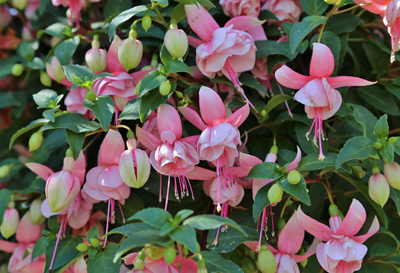 Fuchsias are glorious garden plants which reward the right care with a magnificent display of flowers from mid to late summer right through autumn. Literally thousands of garden cultivars offer a wide variety of forms, from tall and upright, to low and trailing. Flowers may be slim and delicate, or full and flamboyant. With such a range to choose from there is a fuchsia for every garden, whether in the border, a pot on the patio or a hanging basket on the house wall.
Fuchsias are glorious garden plants which reward the right care with a magnificent display of flowers from mid to late summer right through autumn. Literally thousands of garden cultivars offer a wide variety of forms, from tall and upright, to low and trailing. Flowers may be slim and delicate, or full and flamboyant. With such a range to choose from there is a fuchsia for every garden, whether in the border, a pot on the patio or a hanging basket on the house wall.
Growing conditions
All fuchsias need adequate moisture during the growing season. Dry conditions lead to shrivelling blooms and slow growth. They grow in sun or shade, but dislike hot sunshine in the heat of the day. They are well suited to lightly shaded conditions and are usually at their best in the cooler days of autumn. Their preferences make them perfect plants for small gardens.
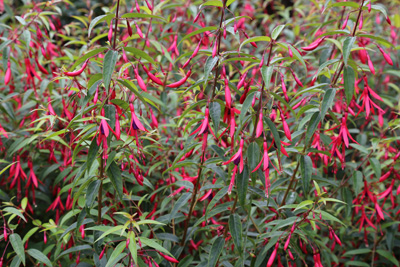 Fuchsias grow on any soil, including chalk. In pots and containers they are best in a loam based growing medium such as John Innes No. 3. This tends to stay cooler and holds more moisture than soil-less growing media.
Fuchsias grow on any soil, including chalk. In pots and containers they are best in a loam based growing medium such as John Innes No. 3. This tends to stay cooler and holds more moisture than soil-less growing media.
Hardiness
Because fuchsias originate from so many regions of the Southern Hemisphere hardiness varies greatly. The hardy species and hybrids, such as the popular Fuchsia ‘Riccartonii’ can be left in the border throughout the year and in milder areas they grow into substantial shrubs. Some are even used for hedging.
Most fuchsias used in pots and hanging baskets are not frost hardy and need winter protection in a greenhouse or conservatory, if you are going to keep them from year to year. Many gardeners treat them as summer bedding plants and start with new ones each season.
New plants
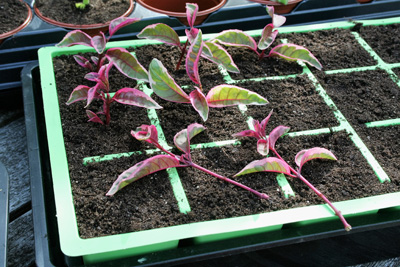 Late spring and early summer is the time that young fuchsia plants become widely available. Look for strong, compact plants and choose varieties that suit the situation. Fuchsias sold for summer bedding may be upright or trailing, the latter are perfect for hanging baskets. Upright varieties are good additions to borders and in patio pots.
Late spring and early summer is the time that young fuchsia plants become widely available. Look for strong, compact plants and choose varieties that suit the situation. Fuchsias sold for summer bedding may be upright or trailing, the latter are perfect for hanging baskets. Upright varieties are good additions to borders and in patio pots.
Plant out after frosts, but if you need to keep them indoors, keep them cool and light. Warm conditions induce weak growth.
If you start early enough you can take cuttings from your new plants. Cutting back the longest shoots encourages the plants to branch and produce bushy growth. Take cuttings about 8-10cm long, just below a leaf joint. They root easily in Multi-Purpose compost in small pots or in a cell tray.
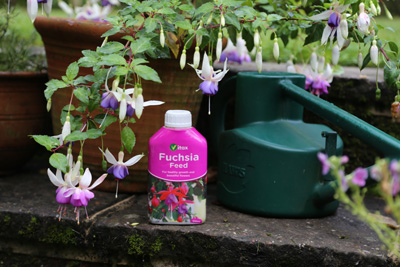 Feeding
Feeding
Because fuchsias need regular watering, especially in pots and containers, soluble nutrients are soon washed from the soil. The plants also grow quickly and need plenty of the right nutrients for flower production. Vitax Fuchsia Feed is the perfect fertiliser for them. A liquid, it is simply added to the watering can about once a week and it quickly delivers all the nutrients your plants need. It is high in potash, which not only stimulates flower production, but also helps to strengthen growth and darken foliage.
Vitax Fuchsia feed can be used on all flowering plants throughout the summer, so it is perfect for all those pots and hanging baskets. It is especially useful to have on hand to give them a boost if they start to look tired after a dry spell.
Whatever the weather
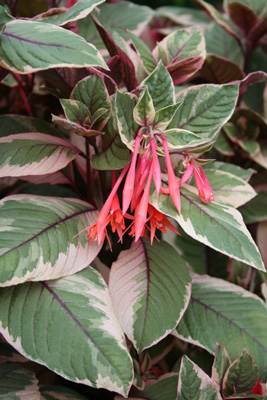 Fuchsias have enjoyed increased popularity because of their great performance in shaded gardens. Also because they are so well suited to the smallest plots, including courtyards and balconies. They are reliable whatever the weather. So if summer brings more cloud and rain than sunshine, fuchsias keep flowering where other summer subjects falter.
Fuchsias have enjoyed increased popularity because of their great performance in shaded gardens. Also because they are so well suited to the smallest plots, including courtyards and balconies. They are reliable whatever the weather. So if summer brings more cloud and rain than sunshine, fuchsias keep flowering where other summer subjects falter.
Andy McIndoe
Your login details have been used by another user or machine. Login details can only be used once at any one time so you have therefore automatically been logged out. Please contact your sites administrator if you believe this other user or machine has unauthorised access.












